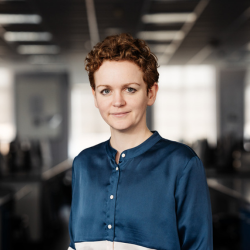Biography
My research combines my expertise in cellular membrane dynamics and host:pathogen interactions. I study how bacterial pathogens interact with and manipulate eukaryotic membranes to enable their own growth and pathogenicity.
Following my undergraduate studies at the University of Cambridge, I completed my PhD at EMBL in Heidelberg, Germany in the lab of Marko Kaksonen. My PhD research focused on how endocytic proteins are recruited to the plasma membrane to initiate endocytosis. Using yeast genetics and live cell fluorescence microscopy techniques I demonstrated a remarkable level of flexibility in the initiation step of endocytosis.
My interests then shifted to host-pathogen interactions and the ways in which intracellular bacteria interact with and hijack the membranes of their host cells to aid their pathogenicity. I carried out my postdoc in the lab of David Holden at Imperial College London. During this time, I determined how a Salmonella virulence protein hijacks host cell trafficking pathways to disrupt the adaptive immune response.
I have now established my own research group in a position joint between the Departments of Pathology and Biochemistry in Cambridge. My group aims to study how different bacterial pathogens have adapted to interact with host cell membrane compartments.
Research
Investigating the interactions of pathogenic bacteria with eukaryotic membranes
In the Godlee group we are studying how bacterial virulence proteins interact with eukaryotic membranes during infection and how this enables disease. In particular, we focus on Salmonella and E. coli, which together cause hundreds of millions of infections annually, with outcomes ranging from gastroenteritis to death. Through this research we are revealing new understanding into this essential element of host-pathogen interactions, as well as providing fundamental insights into cellular membrane biology.
During infection, bacterial virulence proteins have access to the organised membrane systems of the eukaryotic cell. The different ways in which virulence proteins interact with eukaryotic membranes are essential for pathogenesis. In the eukaryotic cell, a complex and diverse range of mechanisms are required to sort proteins to the appropriate membrane compartment for their functions. These include membrane recruitment, integration, and trafficking pathways. Our work explores how bacterial pathogenic proteins overcome the challenges of membrane sorting, either through hijacking eukaryotic pathways or by developing their own distinct mechanisms.
Publications
Godlee, C., & Holden, D. W. (2023). Transmembrane substrates of type three secretion system injectisomes. Microbiology (Reading, England), 169(1). https://doi.org/10.1099/mic.0.001292
Godlee, C., Cerny, O., Liu, M., Blundell, S., Gallagher, A. E., Shahin, M., & Holden, D. W. (2022). The Salmonella transmembrane effector SteD hijacks AP1-mediated vesicular trafficking for delivery to antigen-loading MHCII compartments. PLoS Pathogens, 18(5), e1010252. https://doi.org/10.1371/journal.ppat.1010252
Cerny, O., Godlee, C., Tocci, R., Cross, N. E., Shi, H., Williamson, J. C., Alix, E., Lehner, P. J., & Holden, D. W. (2021). CD97 stabilises the immunological synapse between dendritic cells and T cells and is targeted for degradation by the Salmonella effector SteD. PLoS Pathogens, 17(7), e1009771. https://doi.org/10.1371/journal.ppat.1009771
Alix, E., Godlee, C., Cerny, O., Blundell, S., Tocci, R., Matthews, S., Liu, M., Pruneda, J. N., Swatek, K. N., Komander, D., Sleap, T., & Holden, D. W. (2020). The Tumour Suppressor TMEM127 Is a Nedd4-Family E3 Ligase Adaptor Required by Salmonella SteD to Ubiquitinate and Degrade MHC Class II Molecules. Cell Host & Microbe, 28(1), 54-68.e7. https://doi.org/10.1016/j.chom.2020.04.024
Godlee, C., Cerny, O., Durkin, C. H., & Holden, D. W. (2019). SrcA is a chaperone for the Salmonella SPI-2 type three secretion system effector SteD. Microbiology (Reading, England), 165(1), 15–25. https://doi.org/10.1099/mic.0.000732
Brach, T., Godlee, C., Moeller-Hansen, I., Boeke, D., & Kaksonen, M. (2014). The initiation of clathrin-mediated endocytosis is mechanistically highly flexible. Current Biology : CB, 24(5), 548–554. https://doi.org/10.1016/j.cub.2014.01.048
Godlee, C., & Kaksonen, M. (2013). From uncertain beginnings: Initiation mechanisms of clathrin-mediated endocytosis. The Journal of Cell Biology, 203(5), 717–725. https://doi.org/10.1083/jcb.201307100


